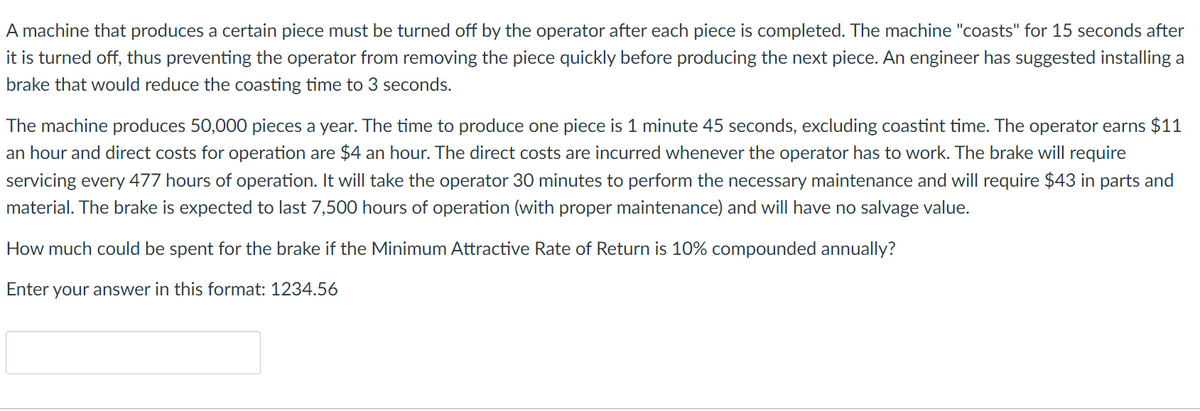off, thus preventing the operator from removing the piece quickly before producing th would reduce the coasting time to 3 seconds. e produces 50,000 pieces a year. The time to produce one piece is 1 minute 45 secon direct costs for operation are $4 an hour. The direct costs are incurred whenever the ery 477 hours of operation. It will take the operator 30 minutes to perform the neces e brake is expected to last 7,500 hours of operation (with proper maintenance) and w could be spent for the brake if the Minimum Attractive Rate of Return is 10% compou nswer in this format: 1234.56
off, thus preventing the operator from removing the piece quickly before producing th would reduce the coasting time to 3 seconds. e produces 50,000 pieces a year. The time to produce one piece is 1 minute 45 secon direct costs for operation are $4 an hour. The direct costs are incurred whenever the ery 477 hours of operation. It will take the operator 30 minutes to perform the neces e brake is expected to last 7,500 hours of operation (with proper maintenance) and w could be spent for the brake if the Minimum Attractive Rate of Return is 10% compou nswer in this format: 1234.56
Managerial Economics: A Problem Solving Approach
5th Edition
ISBN:9781337106665
Author:Luke M. Froeb, Brian T. McCann, Michael R. Ward, Mike Shor
Publisher:Luke M. Froeb, Brian T. McCann, Michael R. Ward, Mike Shor
Chapter17: Making Decisions With Uncertainty
Section: Chapter Questions
Problem 17.1IP
Related questions
Question
4

Transcribed Image Text:A machine that produces a certain piece must be turned off by the operator after each piece is completed. The machine "coasts" for 15 seconds after
it is turned off, thus preventing the operator from removing the piece quickly before producing the next piece. An engineer has suggested installing a
brake that would reduce the coasting time to 3 seconds.
The machine produces 50,000 pieces a year. The time to produce one piece is 1 minute 45 seconds, excluding coastint time. The operator earns $11
an hour and direct costs for operation are $4 an hour. The direct costs are incurred whenever the operator has to work. The brake will require
servicing every 477 hours of operation. It will take the operator 30 minutes to perform the necessary maintenance and will require $43 in parts and
material. The brake is expected to last 7,500 hours of operation (with proper maintenance) and will have no salvage value.
How much could be spent for the brake if the Minimum Attractive Rate of Return is 10% compounded annually?
Enter your answer in this format: 1234.56
Expert Solution
This question has been solved!
Explore an expertly crafted, step-by-step solution for a thorough understanding of key concepts.
Step by step
Solved in 2 steps

Knowledge Booster
Learn more about
Need a deep-dive on the concept behind this application? Look no further. Learn more about this topic, economics and related others by exploring similar questions and additional content below.Recommended textbooks for you

Managerial Economics: A Problem Solving Approach
Economics
ISBN:
9781337106665
Author:
Luke M. Froeb, Brian T. McCann, Michael R. Ward, Mike Shor
Publisher:
Cengage Learning

Managerial Economics: A Problem Solving Approach
Economics
ISBN:
9781337106665
Author:
Luke M. Froeb, Brian T. McCann, Michael R. Ward, Mike Shor
Publisher:
Cengage Learning